Balancing Sustainability and Comfort: A Holistic Study of Building Control Strategies That Meet the Global Standards for Efficiency and Thermal Comfort
Abstract
1. Introduction
2. Methodology
- What are the national and international regulations and standards governing the energetic envelop and thermal comfort in buildings?
- What building modeling methods are available in the literature?
- What control methods are currently deployed in buildings to minimize energy consumption and ensure thermal comfort?
- What is a smart building?
- How are these control methods evaluated in the literature, and how does the term smart building contribute to this evaluation process?
3. Analysis
3.1. Notions and Standards
- ISO50001
- ISO7730
- ASHRAE90.1
- NF EN 15232
- NF EN 16247
- Japan
- India
- Canada
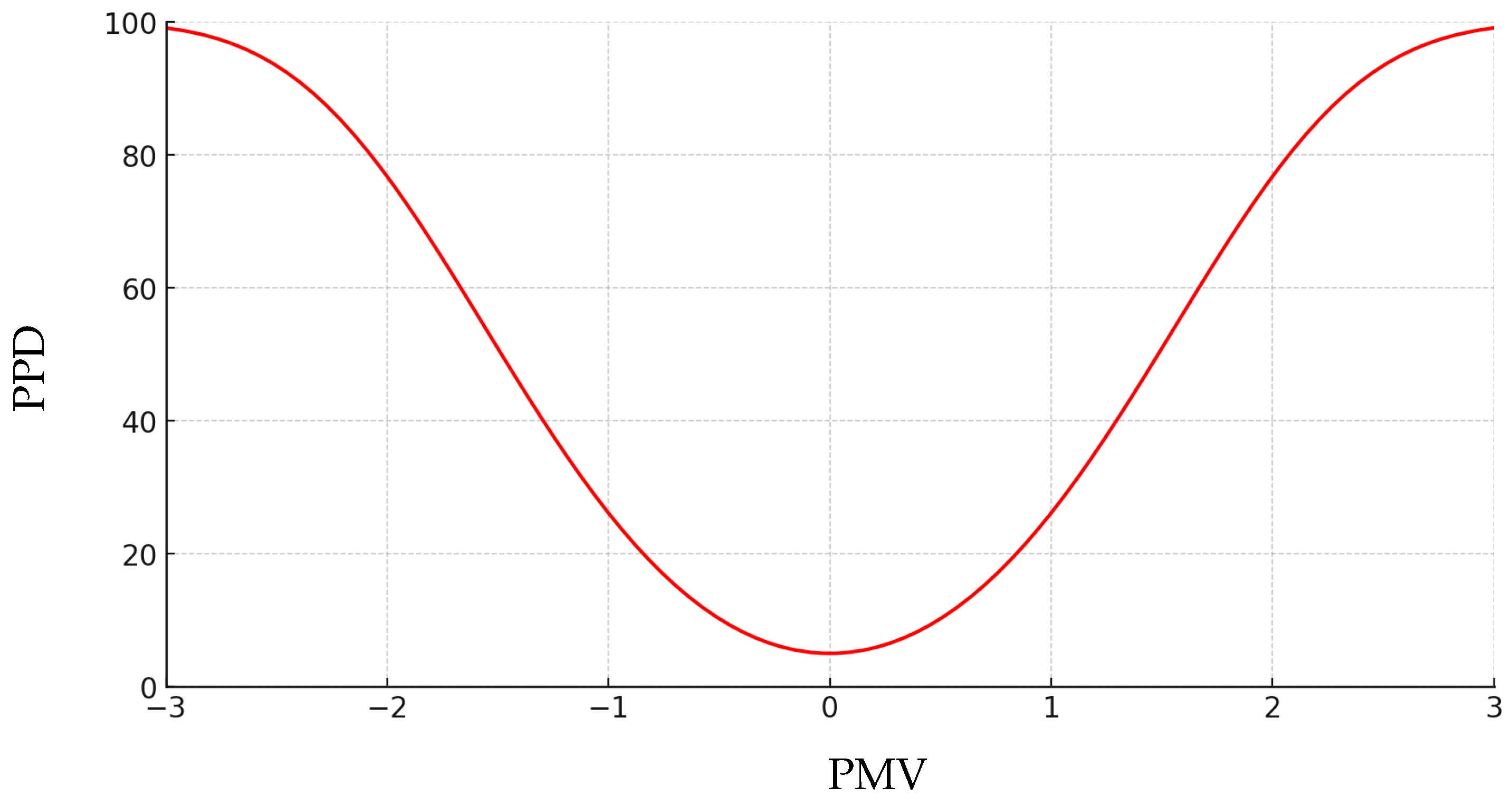
- Spain
- Algeria
- Italy
- Tunisia
- Morocco
- BREEAM
- HQE

3.2. Building Modeling Approaches
3.3. Classification of Control Strategies in Buildings
3.3.1. Conventional Control Strategy
| Control System | Advantages | Disadvantages | Ref. |
|---|---|---|---|
| On/off control | Simple and easy to implement, low cost | Poor temperature control, can cause wear and tear on HVAC equipment | [76] |
| Energy-efficient, reduces carbon emissions | Poor temperature control, limited application in areas without favorable climatic conditions | [89] | |
| Simple and adaptable control methods | Limited accuracy and performance compared to more advanced control techniques | [83] | |
| Cost-effective, energy-efficient, adaptable to various HVAC systems | Limited accuracy and performance compared to more advanced control techniques | [76] | |
| Improved energy efficiency, better temperature control | Can be complex and expensive to implement | [90] | |
| PID control | Improved energy efficiency, better temperature control | Complex system modeling required data | [88] |
| Improved temperature control, adaptable to various HVAC systems | Require expert knowledge and time-consuming turning | [76,85] | |
| Improved temperature control, adaptable to various HVAC systems | - | [81] | |
| Fast response improved performance, adaptable to nonlinear objects | May require complex implementation and parameter turning | [91] | |
| Simple and inexpensive | Poor control, accuracy, and stability | [77] |
3.3.2. Advanced Control Strategies
Model Predictive Control (MPC)
- Types of MPC
- Robust model predictive control (RMPC)
- 2.
- Stochastic model predictive control (SMPC)
- 3.
- Distributed model predictive control (DMPC)
- 4.
- Adaptive model predictive control (AMPC)
- 5.
- Hybrid model predictive control (HMPC)
Optimal Control
Adaptive Control
3.3.3. Intelligent Control Strategies
Fuzzy Logic (FL)
Deep Learning Based on Artificial Neural Network (ANN)
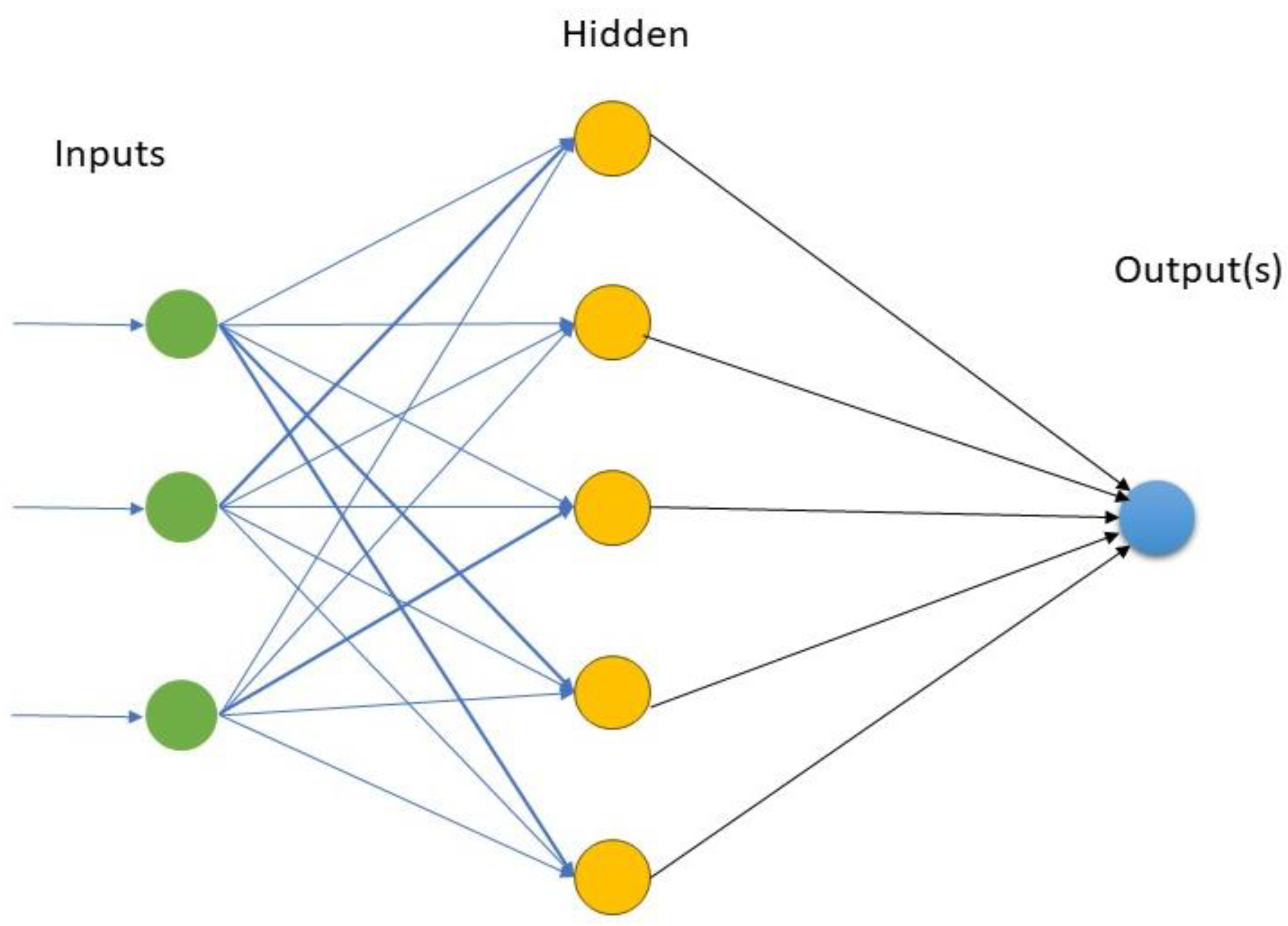
Reinforcement Learning (RL)
Transfer Learning (TL)
4. Discussion
- Load management;
- Efficiency;
- Error reduction;
- Transient responsiveness;
- Decision variable management;
- Operational efficiency;
- Set-point regulation;
- Operational stability;
- Environmental quality;
- Computational efficiency.
5. Hardware Implementation
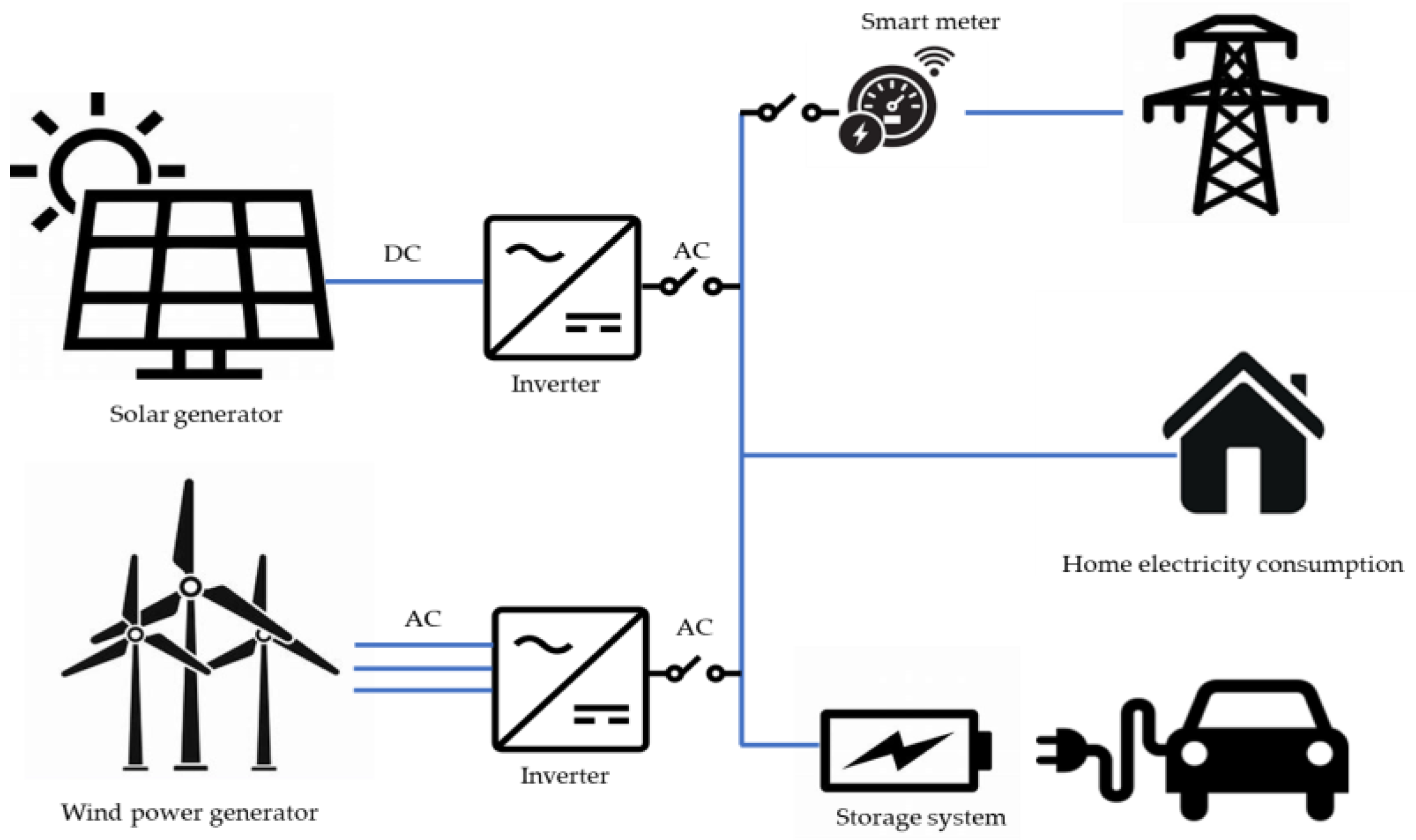
6. Conclusions
Author Contributions
Funding
Data Availability Statement
Conflicts of Interest
Abbreviations
| MIQP | Mixed Integer Quadratic Programming |
| AI | Artificial Intelligence |
| ANN | Artificial Neural Network |
| FL | Fuzzy Logic |
| HVAC | Heating, Ventilation, and Air-Conditioning |
| IOT | Internet of Things |
| ISO | International Organization for Standardization |
| LSTM | Long Short-Term Memory |
| MILP | Mixed-Integer Linear Programming |
| MIMO | Multiple-Input Multiple-Output |
| MPC | Model Predictive Control |
| PID | Proportional Integral Derivative |
| PMV | Predicted Mean Vote |
| PPD | Predicted Percentage of Dissatisfied |
| RL | Reinforcement Learning |
| TL | Transfer Learning |
| TR | Thermal Regulations |
References
- What Is Climate Change?|United Nations. Available online: https://www.un.org/en/climatechange/what-is-climate-change (accessed on 30 October 2023).
- Groumpos, P.P. A Critical Historical and Scientific Overview of All Industrial Revolutions. IFAC-PapersOnLine 2021, 54, 464–471. [Google Scholar] [CrossRef]
- Vinitha, K.; Prabhu, R.A.; Bhaskar, R.; Hariharan, R. Review on Industrial Mathematics and Materials at Industry 1.0 to Industry 4.0; Elsevier: Amsterdam, The Netherlands, 2020. [Google Scholar]
- Mckoy, D.Q.R.; Tesiero, R.C.; Acquaah, Y.T.; Gokaraju, B. Review of HVAC Systems History and Future Applications. Energies 2023, 16, 6109. [Google Scholar] [CrossRef]
- Dickinson, H.W.; Musson, A.E. A Short History of the Steam Engine; Routledge: London, UK, 2022; pp. 1–255. [Google Scholar] [CrossRef]
- Climate Change 2021: The Physical Science Basis|Climate Change 2021: The Physical Science Basis. Available online: https://www.ipcc.ch/report/ar6/wg1/ (accessed on 2 January 2024).
- Climate Change. Available online: https://www.who.int/news-room/fact-sheets/detail/climate-change-and-health (accessed on 1 January 2024).
- Vicente-Serrano, S.M.; Quiring, S.M.; Peña-Gallardo, M.; Yuan, S.; Domínguez-Castro, F. A Review of Environmental Droughts: Increased Risk under Global Warming? Earth Sci. Rev. 2020, 201, 102953. [Google Scholar] [CrossRef]
- Al-Ghussain, L. Global Warming: Review on Driving Forces and Mitigation. Environ. Prog. Sustain. Energy 2019, 38, 13–21. [Google Scholar] [CrossRef]
- U.S. Energy Facts Explained—Consumption and Production—U.S. Energy Information Administration (EIA). Available online: https://www.eia.gov/energyexplained/us-energy-facts/ (accessed on 10 November 2023).
- Fossil Fuels—Energy System—IEA. Available online: https://www.iea.org/energy-system/fossil-fuels (accessed on 10 November 2023).
- Huang, J.B.; Wang, S.W.; Luo, Y.; Zhao, Z.C.; Wen, X.Y. Debates on the Causes of Global Warming. Adv. Clim. Chang. Res. 2012, 3, 38–44. [Google Scholar] [CrossRef]
- Torabi, M.; Mahdavinejad, M. Past and Future Trends on the Effects of Occupant Behaviour on Building Energy Consumption. J. Sustain. Arch. Civ. Eng. 2021, 29, 83–101. [Google Scholar] [CrossRef]
- U.S. Energy Information Administration—EIA—Independent Statistics and Analysis. Available online: https://www.eia.gov/environment/emissions/carbon/ (accessed on 30 October 2023).
- Shi, H.; Chen, Q. Building Energy Management Decision-Making in the Real World: A Comparative Study of HVAC Cooling Strategies. J. Build. Eng. 2021, 33, 101869. [Google Scholar] [CrossRef]
- Slabe-Erker, R.; Dominko, M.; Bayar, A.; Majcen, B.; Primc, K. Energy Efficiency in Residential and Non-Residential Buildings: Short-Term Macroeconomic Implications. Build. Environ. 2022, 222, 109364. [Google Scholar] [CrossRef]
- Nižetić, S.; Arıcı, M.; Hoang, A.T. Smart and Sustainable Technologies in Energy Transition. J. Clean. Prod. 2023, 389, 135944. [Google Scholar] [CrossRef]
- De La Peña, L.; Guo, R.; Cao, X.; Ni, X.; Zhang, W. Accelerating the Energy Transition to Achieve Carbon Neutrality. Resour. Conserv. Recycl. 2022, 177, 105957. [Google Scholar] [CrossRef]
- Tovar-Facio, J.; Martín, M.; Ponce-Ortega, J.M. Sustainable Energy Transition: Modeling and Optimization. Curr. Opin. Chem. Eng. 2021, 31, 100661. [Google Scholar] [CrossRef]
- Al Dakheel, J.; Del Pero, C.; Aste, N.; Leonforte, F. Smart Buildings Features and Key Performance Indicators: A Review. Sustain. Cities Soc. 2020, 61, 102328. [Google Scholar] [CrossRef]
- Sampaio, P.G.V.; González, M.O.A. Photovoltaic Solar Energy: Conceptual Framework. Renew. Sustain. Energy Rev. 2017, 74, 590–601. [Google Scholar] [CrossRef]
- Ballarini, I.; De Luca, G.; Paragamyan, A.; Pellegrino, A.; Corrado, V. Transformation of an Office Building into a Nearly Zero Energy Building (NZEB): Implications for Thermal and Visual Comfort and Energy Performance. Energies 2019, 12, 895. [Google Scholar] [CrossRef]
- Herrando, M.; Ramos, A. Photovoltaic-Thermal (PV-T) Systems for Combined Cooling, Heating and Power in Buildings: A Review. Energies 2022, 15, 3021. [Google Scholar] [CrossRef]
- Al-Yasiri, Q.; Szabó, M.; Arıcı, M. A Review on Solar-Powered Cooling and Air-Conditioning Systems for Building Applications. Energy Rep. 2022, 8, 2888–2907. [Google Scholar] [CrossRef]
- Delač, B.; Pavković, B.; Lenić, K.; Mađerić, D. Integrated Optimization of the Building Envelope and the HVAC System in NZEB Refurbishment. Appl. Therm. Eng. 2022, 211, 118442. [Google Scholar] [CrossRef]
- Balbis-Morejón, M.; Cabello-Eras, J.J.; Rey-Hernández, J.M.; Isaza-Roldan, C.; Rey-Martínez, F.J. Selection of HVAC Technology for Buildings in the Tropical Climate Case Study. Alex. Eng. J. 2023, 69, 469–481. [Google Scholar] [CrossRef]
- Albatayneh, A.; Jaradat, M.; Al-Omary, M.; Zaquot, M. Evaluation of Coupling PV and Air Conditioning vs. Solar Cooling Systems—Case Study from Jordan. Appl. Sci. 2021, 11, 511. [Google Scholar] [CrossRef]
- Wurtz, F.; Delinchant, B. “Smart Buildings” Integrated in “Smart Grids”: A Key Challenge for the Energy Transition by Using Physical Models and Optimization with a “Human-in-the-Loop” Approach. Comptes Rendus Phys. 2017, 18, 428–444. [Google Scholar] [CrossRef]
- Kim, D.; Yoon, Y.; Lee, J.; Mago, P.J.; Lee, K.; Cho, H. Design and Implementation of Smart Buildings: A Review of Current Research Trend. Energies 2022, 15, 4278. [Google Scholar] [CrossRef]
- UNICEF and the Sustainable Development Goals|UNICEF. Available online: https://www.unicef.org/sustainable-development-goals (accessed on 1 December 2023).
- Goal 11|Department of Economic and Social Affairs. Available online: https://sdgs.un.org/goals/goal11 (accessed on 1 December 2023).
- SDG Goal 7: Affordable and Clean Energy—UNICEF DATA. Available online: https://data.unicef.org/sdgs/goal-7-affordable-clean-energy/ (accessed on 1 December 2023).
- Afonso, J.A.; Monteiro, V.; Afonso, J.L. Internet of Things Systems and Applications for Smart Buildings. Energies 2023, 16, 2757. [Google Scholar] [CrossRef]
- Metallidou, C.K.; Psannis, K.E.; Egyptiadou, E.A. Energy Efficiency in Smart Buildings: IoT Approaches. IEEE Access 2020, 8, 63679–63699. [Google Scholar] [CrossRef]
- Siountri, K.; Skondras, E.; Vergados, D.D. Developing Smart Buildings Using Blockchain, Internet of Things, and Building Information Modeling. Int. J. Interdiscip. Telecommun. Netw. 2020, 12, 1–15. [Google Scholar] [CrossRef]
- Key World Energy Statistics 2021—Analysis—IEA. Available online: https://www.iea.org/reports/key-world-energy-statistics-2021 (accessed on 25 September 2023).
- Consumption of Coal and Lignite|World Coal Consumption|Enerdata. Available online: https://yearbook.enerdata.net/coal-lignite/coal-world-consumption-data.html (accessed on 3 January 2024).
- Theses.Fr—Badr Chegari, Contribution à l’intégration de Systèmes de Gestion Optimale de l’énergie Pour Les Bâtiments Intelligents. Available online: https://www.theses.fr/2022GRALT057 (accessed on 1 December 2023).
- ISO 50001:2018; Systèmes de Management de l’énergie. Exigences et Recommandations Pour La Mise En Oeuvre. ISO: Geneva, Switzerland, 2018. Available online: https://www.iso.org/fr/standard/69426.html (accessed on 21 September 2023).
- ISO 7730:2005; Ergonomics of the Thermal Environment—Analytical Determination and Interpretation of Thermal Comfort Using Calculation of the PMV and PPD Indices and Local Thermal Comfort Criteria. ISO: Geneva, Switzerland, 2005. Available online: https://www.iso.org/standard/39155.html (accessed on 21 September 2023).
- ISO 7730:2005; (Fr), Ergonomie Des Ambiances Thermiques—Détermination Analytique et Interprétation Du Confort Thermique Par Le Calcul Des Indices PMV et PPD et Par Des Critères de Confort Thermique Local. ISO: Geneva, Switzerland, 2005. Available online: https://www.iso.org/obp/ui/fr/#iso:std:iso:7730:ed-3:v1:fr (accessed on 25 September 2023).
- Ferguson, S.C.; Harrold, R.M.; Skalko, S.V.; Peglow, T.M.; Conrad, E.A.; Erbe, D.H.; Eric, V.-C.; Richman, E.; Garrigus, J.A.; Lane, M.D.; et al. ASHRAE Standing Standard Project Committee 90.1 Cognizant TC: TC 7.6., Systems Energy Utilization SPLS Li-aison: Mark Modera ASHRAE Staff Liaison. Available online: https://www.ashrae.org/File%20Library/Technical%20Resources/Standards%20and%20Guidelines/Standards%20Addenda/90-1-2007/90_1_2007_ag_ai_aj_ak_ay_bc_bd.pdf (accessed on 25 September 2023).
- Norme NF EN 15232. Available online: https://www.boutique.afnor.org/fr-fr/norme/nf-en-15232/performance-energetique-des-batiments-impact-de-lautomatisation-de-la-regul/fa170845/39679 (accessed on 1 December 2023).
- Audits Énergétiques NF EN 16247. Available online: https://competences.afnor.org/gammes/audits-energetiques-nf-en-16247 (accessed on 5 December 2023).
- Energy Efficiency Building Standards in Japan. Available online: http://www.asiabusinesscouncil.org/docs/BEE/papers/BEE_Policy_Japan.pdf (accessed on 7 December 2023).
- Evans, M.; Shui, B.; Somasundaram, S. Country Report on Building Energy Codes in India; PNNL-17925; USDOE: Washington, DC, USA, 2009. [Google Scholar] [CrossRef]
- National Energy Code of Canada for Buildings: 2017—NRC Publications Archive—Canada. Available online: https://nrc-publications.canada.ca/eng/view/object/?id=3eea8f31-47ef-4280-86b0-1c148744f8f1 (accessed on 9 December 2023).
- Indice PMV—PPD de Confort Thermique|Beswic. Available online: https://www.beswic.be/fr/themes/agents-physiques/ambiances-thermiques/indices-de-confort-et-de-contrainte-thermique/indice-pmv-ppd-de-confort-thermique (accessed on 25 September 2023).
- BOE.Es—DOUE-L-2013-82903 Reglamento (UE) No 1308/2013 Del Parlamento Europeo y Del Consejo, de 17 de Diciembre de 2013, Por El Que Se Crea La Organización Común de Mercados de Los Productos Agrarios y Por El Que Se Derogan Los Reglamentos (CEE) No 922/72, (CEE) No 234/79, (CE) No 1037/2001 y (CE) No 1234/2007. Available online: https://www.boe.es/buscar/doc.php?id=DOUE-L-2013-82903 (accessed on 26 September 2023).
- Réglementation Thermique Des Bâtiments D’habitation—Règles de Calcul Des Déperditions Calorifiques DTR C32|PDF|La Nature. Available online: https://fr.scribd.com/document/490156720/Reglementation-thermique-des-batiments-d-habitation-Regles-de-calcul-des-deperditions-calorifiques-DTR-C32# (accessed on 26 September 2023).
- (PDF) REPUBLIQUE ALGERIENNE DEMOCRATIQUE ET POPULAIRE MINISTERE DE L’HABITAT Document Technique Réglementaire|a b—Academia.Edu. Available online: https://www.academia.edu/36444711/REPUBLIQUE_ALGERIENNE_DEMOCRATIQUE_ET_POPULAIRE_MINISTERE_DE_LHABITAT_Document_Technique_R%C3%A9glementaire?uc-g-sw=31831267 (accessed on 26 September 2023).
- Teprima, P.R. Gazzetta Ufficiale Della Repubblica Italiana Direzione e Redazione Presso IL Ministero Della Giustizia-Ufficio Pubblicazione Leggi e Decreti-Via Arenula 70-00186 Roma Amministrazione Presso L’istituto Poligrafico e Zecca Dello Stato-Via Salaria 1027-00138 Roma-Centralino 06-85081-Libreria Dello Stato via Principe Umberto 4, 00185 ROMA. Available online: https://www.giustizia.it/giustizia/it/mg_1_16.page (accessed on 26 September 2023).
- (PDF) Building Energy Labeling in Tunisia. Available online: https://www.researchgate.net/publication/313792042_Building_Energy_labeling_in_Tunisia (accessed on 12 February 2024).
- ANME. Available online: https://www.anme.tn/ (accessed on 26 September 2023).
- Le Règlement Thermique de Construction Au Maroc Version Simplifiée Guide Pratique Destiné Aux Professionnels. Available online: https://fr.scribd.com/document/501390965/Le-reglement-thermique (accessed on 23 September 2023).
- Oc, E. Climat, Air et Energie: Chiffres Clés 2015|ADEME—Envirobat Oc. 2023. Available online: https://www.envirobat-oc.fr (accessed on 1 December 2023).
- Le Rapport Final Comparaison Internationale Bâtiment et Énergie: 31 March 2008. Available online: https://www.batiweb.com/actualites/vie-pratique/le-rapport-final-comparaison-internationale-batiment-et-energie-9638 (accessed on 1 December 2023).
- Evaluating Buildings: 12 Green Building Certifications to Know|ArchDaily. Available online: https://www.archdaily.com/946290/evaluating-buildings-12-green-building-certifications-to-know (accessed on 1 December 2023).
- BRE. SAP 2012 The Governments Standard Assessment Procedure for Energy Rating of Dwellings 2012 Edition; BRE: Watford, UK, 2014. [Google Scholar]
- Doussard, C. Assessment of Sustainable Neighbourhoods: From Standards to Cultural Practices. 2017. Available online: https://www.witpress.com/elibrary/sdp-volumes/12/3/1471 (accessed on 15 December 2023).
- Villot, J.; Gondran, N.; Laforest, V. Labels de La Construction: Quelle Contribution Possible Au Facteur 4? Dev. Durable Territ. 2011, 2, 1–31. [Google Scholar] [CrossRef]
- Atam, E.; Helsen, L. Control-Oriented Thermal Modeling of Multizone Buildings: Methods and Issues: Intelligent Control of a Building System. IEEE Control. Syst. Mag. 2016, 36, 86–111. [Google Scholar] [CrossRef]
- EnergyPlus. Available online: https://energyplus.net/ (accessed on 31 August 2023).
- Chen, Y.; Guo, M.; Chen, Z.; Chen, Z.; Ji, Y. Physical Energy and Data-Driven Models in Building Energy Prediction: A Review. Energy Rep. 2022, 8, 2656–2671. [Google Scholar] [CrossRef]
- Trčka, M.; Hensen, J.L.M. Overview of HVAC System Simulation. Autom. Constr. 2010, 19, 93–99. [Google Scholar] [CrossRef]
- Magnier, L.; Haghighat, F. Multiobjective Optimization of Building Design Using TRNSYS Simulations, Genetic Algorithm, and Artificial Neural Network. Build. Environ. 2010, 45, 739–746. [Google Scholar] [CrossRef]
- EnergyPlus. Available online: https://energyplus.net/downloads (accessed on 29 July 2023).
- Crawley, D.B.; Lawrie, L.K.; Winkelmann, F.C.; Buhl, W.F.; Huang, Y.J.; Pedersen, C.O.; Strand, R.K.; Liesen, R.J.; Fisher, D.E.; Witte, M.J.; et al. EnergyPlus: Creating a New-Generation Building Energy Simulation Program. Energy Build. 2001, 33, 319–331. [Google Scholar] [CrossRef]
- Fumo, N.; Mago, P.; Luck, R. Methodology to Estimate Building Energy Consumption Using EnergyPlus Benchmark Models. Energy Build. 2010, 42, 2331–2337. [Google Scholar] [CrossRef]
- Jani, D.B.; Bhabhor, K.; Dadi, M.; Doshi, S.; Jotaniya, P.V.; Ravat, H.; Bhatt, K. A Review on Use of TRNSYS as Simulation Tool in Performance Prediction of Desiccant Cooling Cycle. J. Therm. Anal. Calorim. 2020, 140, 2011–2031. [Google Scholar] [CrossRef]
- Mazzeo, D.; Matera, N.; Cornaro, C.; Oliveti, G.; Romagnoni, P.; De Santoli, L. EnergyPlus, IDA ICE and TRNSYS Predictive Simulation Accuracy for Building Thermal Behaviour Evaluation by Using an Experimental Campaign in Solar Test Boxes with and without a PCM Module. Energy Build. 2020, 212, 109812. [Google Scholar] [CrossRef]
- Lu, Q.; Lee, S. Image-Based Technologies for Constructing As-Is Building Information Models for Existing Buildings. J. Comput. Civ. Eng. 2017, 31, 04017005. [Google Scholar] [CrossRef]
- Li, X.; Wen, J. Review of Building Energy Modeling for Control and Operation. Renew. Sustain. Energy Rev. 2014, 37, 517–537. [Google Scholar] [CrossRef]
- Chen, W.H.; You, F. Sustainable Building Climate Control with Renewable Energy Sources Using Nonlinear Model Predictive Control. Renew. Sustain. Energy Rev. 2022, 168, 112830. [Google Scholar] [CrossRef]
- Broholt, T.H.; Knudsen, M.D.; Petersen, S. The Robustness of Black and Grey-Box Models of Thermal Building Behaviour against Weather Changes. Energy Build. 2022, 275, 112460. [Google Scholar] [CrossRef]
- Naylor, S.; Gillott, M.; Lau, T. A Review of Occupant-Centric Building Control Strategies to Reduce Building Energy Use. Renew. Sustain. Energy Rev. 2018, 96, 1–10. [Google Scholar] [CrossRef]
- Behrooz, F.; Mariun, N.; Marhaban, M.H.; Amran, M.; Radzi, M.; Ramli, A.R. Review of Control Techniques for HVAC Systems—Nonlinearity Approaches Based on Fuzzy Cognitive Maps. Energies 2018, 11, 495. [Google Scholar] [CrossRef]
- Gholamzadehmir, M.; Del Pero, C.; Buffa, S.; Fedrizzi, R. Adaptive-Predictive Control Strategy for HVAC Systems in Smart Buildings—A Review. Sustain. Cities Society 2020, 63, 102480. [Google Scholar] [CrossRef]
- Paris, B.; Eynard, J.; Grieu, S.; Polit, M. Hybrid PID-Fuzzy Control Scheme for Managing Energy Resources in Buildings. Appl. Soft Comput. 2011, 11, 5068–5080. [Google Scholar] [CrossRef]
- Homod, R.Z.; Sahari, K.S.M.; Mohamed, H.A.; Nagi, F. Hybrid PID-cascade control for HVAC system. Int. J. Syst. Control. 2010, 1, 170–175. [Google Scholar]
- Yamazaki, T.; Yamakawa, Y.; Kamimura, K.; Kurosu, S. Air-Conditioning PID Control System with Adjustable Reset to Offset Thermal Loads Upsets. In Advances in PID Control; Springer: London, UK, 2011. [Google Scholar] [CrossRef]
- Peng, Y.; Lei, Y.; Tekler, Z.D.; Antanuri, N.; Lau, S.K.; Chong, A. Hybrid System Controls of Natural Ventilation and HVAC in Mixed-Mode Buildings: A Comprehensive Review. Energy Build. 2022, 276, 112509. [Google Scholar] [CrossRef]
- Mirinejad, H.; Sadati, S.H.; Ghasemian, M.; Torab, H. Control Techniques in Heating, Ventilating and Air Conditioning Systems. J. Comput. Sci. 2008, 4, 777–783. [Google Scholar] [CrossRef]
- Pfeiffer, C.; Skeie, N.; Perera, D. Control of Temperature and Energy Consumption in Buildings—A Review. Int. J. Energy Environ. 2014, 5, 471–484. [Google Scholar]
- Somefun, O.A.; Akingbade, K.; Dahunsi, F. The Dilemma of PID Tuning. Annu. Rev. Control 2021, 52, 65–74. [Google Scholar] [CrossRef]
- Fazelpour, F.; Asnaashari, R. HVAC System Energy Saving in a Sample Building through Synergic Earth-Air Heat Exchanger and Closed Loop Control. In Proceedings of the 2015 IEEE 15th International Conference on Environment and Electrical Engineering, Rome, Italy, 10–13 June 2015; pp. 1549–1555. [Google Scholar] [CrossRef]
- Shein, W.W.; Tan, Y.; Lim, A.O. PID Controller for Temperature Control with Multiple Actuators in Cyber-Physical Home System. In Proceedings of the 2012 15th International Conference on Network-Based Information Systems, Melbourne, Australia, 26–28 September 2012; pp. 423–428. [Google Scholar] [CrossRef]
- Kulkarni, M.R.; Hong, F. Energy Optimal Control of a Residential Space-Conditioning System Based on Sensible Heat Transfer Modeling. Build. Environ. 2004, 39, 31–38. [Google Scholar] [CrossRef]
- Solano, J.C.; Caamaño-Martín, E.; Olivieri, L.; Almeida-Galárraga, D. HVAC Systems and Thermal Comfort in Buildings Climate Control: An Experimental Case Study. Energy Rep. 2021, 7, 269–277. [Google Scholar] [CrossRef]
- Subbaram Naidu, D.; Rieger, C.G. Advanced Control Strategies for Heating, Ventilation, Air-Conditioning, and Refrigeration Systems—An Overview: Part I: Hard Control. HVAC R Res. 2011, 17, 2–21. [Google Scholar] [CrossRef]
- (PDF) PID-Cascade for HVAC System Control. Available online: https://www.researchgate.net/publication/257727629_PID-Cascade_for_HVAC_System_Control (accessed on 2 May 2023).
- Drgoňa, J.; Arroyo, J.; Cupeiro Figueroa, I.; Blum, D.; Arendt, K.; Kim, D.; Ollé, E.P.; Oravec, J.; Wetter, M.; Vrabie, D.L.; et al. All You Need to Know about Model Predictive Control for Buildings. Annu. Rev. Control 2020, 50, 190–232. [Google Scholar] [CrossRef]
- Yao, Y.; Shekhar, D.K. State of the Art Review on Model Predictive Control (MPC) in Heating Ventilation and Air-Conditioning (HVAC) Field. Build. Environ. 2021, 200, 107952. [Google Scholar] [CrossRef]
- Afram, A.; Janabi-Sharifi, F. Theory and Applications of HVAC Control Systems—A Review of Model Predictive Control (MPC). Build. Environ. 2014, 72, 343–355. [Google Scholar] [CrossRef]
- Huang, G.; Wang, S.; Xu, X. A Robust Model Predictive Control Strategy for Improving the Control Performance of Air-Conditioning Systems. Energy Convers. Manag. 2009, 50, 2650–2658. [Google Scholar] [CrossRef]
- Bünning, F.; Heer, P.; Smith, R.S.; Lygeros, J. Increasing Electrical Reserve Provision in Districts by Exploiting Energy Flexibility of Buildings with Robust Model Predictive Control. Adv. Appl. Energy 2023, 10, 100130. [Google Scholar] [CrossRef]
- Long, Y.; Liu, S.; Xie, L.; Johansson, K.H. A Scenario-Based Distributed Stochastic MPC for Building Temperature Regulation. In Proceedings of the 2014 IEEE International Conference on Automation Science and Engineering (CASE), New Taipei, Taiwan, 18–22 August 2014; pp. 1091–1096. [Google Scholar] [CrossRef]
- Farina, M.; Giulioni, L.; Scattolini, R. Stochastic Linear Model Predictive Control with Chance Constraints—A Review. J. Process Control 2016, 44, 53–67. [Google Scholar] [CrossRef]
- Bay, C.J.; Chintala, R.; Chinde, V.; King, J. Distributed Model Predictive Control for Coordinated, Grid-Interactive Buildings. Appl. Energy 2022, 312, 118612. [Google Scholar] [CrossRef]
- Ma, S.; Zou, Y.; Li, S. Distributed Model Predictive Control with Priority Coordination for Limited Supply Multi-Zone HVAC Systems. J. Process Control 2022, 117, 157–168. [Google Scholar] [CrossRef]
- Khakimova, A.; Kusatayeva, A.; Shamshimova, A.; Sharipova, D.; Bemporad, A.; Familiant, Y.; Shintemirov, A.; Ten, V.; Rubagotti, M. Optimal Energy Management of a Small-Size Building via Hybrid Model Predictive Control. Energy Build. 2017, 140, 1–8. [Google Scholar] [CrossRef]
- Heirung, T.A.N.; Paulson, J.A.; O’Leary, J.; Mesbah, A. Stochastic Model Predictive Control—How Does It Work? Comput. Chem. Eng. 2018, 114, 158–170. [Google Scholar] [CrossRef]
- Tarisciotti, L.; Lo Calzo, G.; Gaeta, A.; Zanchetta, P.; Valencia, F.; Saez, D. A Distributed Model Predictive Control Strategy for Back-to-Back Converters. IEEE Trans. Ind. Electron. 2016, 63, 5867–5878. [Google Scholar] [CrossRef]
- Zhang, H.; Seal, S.; Wu, D.; Bouffard, F.; Boulet, B. Building Energy Management With Reinforcement Learning and Model Predictive Control: A Survey. IEEE Access 2022, 10, 27853–27862. [Google Scholar] [CrossRef]
- Hou, J.; Li, H.; Nord, N.; Huang, G. Model Predictive Control under Weather Forecast Uncertainty for HVAC Systems in University Buildings. Energy Build. 2022, 257, 111793. [Google Scholar] [CrossRef]
- Gao, Y.; Matsunami, Y.; Miyata, S.; Akashi, Y. Model Predictive Control of a Building Renewable Energy System Based on a Long Short-Term Hybrid Model. Sustain. Cities Soc. 2023, 89, 104317. [Google Scholar] [CrossRef]
- Maasoumy, M.; Razmara, M.; Shahbakhti, M.; Vincentelli, A.S. Handling Model Uncertainty in Model Predictive Control for Energy Efficient Buildings. Energy Build. 2014, 77, 377–392. [Google Scholar] [CrossRef]
- Lv, R.; Yuan, Z.; Lei, B.; Zheng, J.; Luo, X. Model Predictive Control with Adaptive Building Model for Heating Using the Hybrid Air-Conditioning System in a Railway Station. Energies 2021, 14, 1996. [Google Scholar] [CrossRef]
- Zhang, Z.; Chong, A.; Poh Lam, K.; Pan, Y.; Zhang, C.; Lu, S. A Deep Reinforcement Learning Approach to Using Whole Building Energy Model for Hvac Optimal Control. In Proceedings of the 2018 Building Performance Analysis Conference and SimBuild, Chicago, IL, USA, 26–28 September 2018. [Google Scholar]
- Chen, B.; Cai, Z.; Bergés, M. Gnu-Rl: A Precocial Reinforcement Learning Solution for Building Hvac Control Using a Differentiable Mpc Policy. In Proceedings of the 6th ACM International Conference on Systems for Energy-Efficient Buildings, Cities, and Transportation, New York, NY, USA, 13–14 November 2019; pp. 316–325. [Google Scholar] [CrossRef]
- Hu, J.; Karava, P. Modeling and Predictive Control of Mixed-Mode Buildings with Matlab/GenOpt. In Proceedings of the AEI 2013: Building Solutions for Architectural Engineering, State College, PA, USA, 3–5 April 2013; pp. 275–284. [Google Scholar] [CrossRef]
- Lewis, F.L. Optimal Control. Scholarpedia 2008, 3, 5354. [Google Scholar] [CrossRef]
- Kim, S.K.; Hong, W.H.; Hwang, J.H.; Jung, M.S.; Park, Y.S. Optimal Control Method for HVAC Systems in Offices with a Control Algorithm Based on Thermal Environment. Buildings 2020, 10, 95. [Google Scholar] [CrossRef]
- Yang, R.; Wang, L. Optimal Control Strategy for HVAC System in Building Energy Management. In Proceedings of the PES T&D 2012, Orlando, FL, USA, 7–10 May 2012. [Google Scholar]
- Landau, I.D.; Lozano, R.; M’Saad, M.; Karimi, A. Introduction to Adaptive Control. Commun. Control. Eng. 2011, 1–33. [Google Scholar] [CrossRef]
- Tumin, W.; Olama, M.M.; Djouadi, S.M. Adaptive Control for Residential HVAC Systems to Support Grid Services. In Proceedings of the 2021 IEEE Power & Energy Society Innovative Smart Grid Technologies Conference (ISGT), Washington, DC, USA, 16–18 February 2021. [Google Scholar] [CrossRef]
- Hamdi, M.; Lachiver, G. A Fuzzy Control System Based on the Human Sensation of Thermal Comfort. In Proceedings of the 1998 IEEE International Conference on Fuzzy Systems Proceedings. IEEE World Congress on Computational Intelligence (Cat. No. 98CH36228), Anchorage, AK, USA, 4–9 May 1998; Volume 1, pp. 487–492. [Google Scholar] [CrossRef]
- Taneva, A.; Atanasova, D.; Daskalov, A. Fuzzy Logic Control in Building Automation Application. Eng. Proc. 2023, 41, 14. [Google Scholar] [CrossRef]
- Modelling of Home Appliances Using Fuzzy Controller. Available online: https://scholar.google.com/scholar?q=Modelling+of+Home+Appliances+Using+Fuzzy+Controller+in+Achieving+Energy+Consumption+and+Cost+Reduction&hl=fr&as_sdt=0&as_vis=1&oi=scholart (accessed on 12 May 2023).
- Fuzzy Control of the Air Conditioning System at Different Operating Pressures|Request PDF. Available online: https://www.researchgate.net/publication/323129724_Fuzzy_Control_of_the_Air_Conditioning_System_at_Different_Operating_Pressures (accessed on 12 May 2023).
- Parvin, K.; Hannan, M.A.; Al-Shetwi, A.Q.; Ker, P.J.; Roslan, M.F.; Mahlia, T.I. Fuzzy Based Particle Swarm Optimization for Modeling Home Appliances towards Energy Saving and Cost Reduction under Demand Response Consideration. IEEE Access 2020, 8, 210784–210799. [Google Scholar] [CrossRef]
- Anastasiadi, C.; Dounis, A.I. Co-Simulation of Fuzzy Control in Buildings and the HVAC System Using BCVTB. Adv. Build. Energy Res. 2018, 12, 195–216. [Google Scholar] [CrossRef]
- Abd Ali, J.; Ahmed, M.S.; Mohamed, A.; Shareef, H.; Homod, R.Z. Artificial Neural Network Based Controller for Home Energy Management Considering Demand Response Events. In Proceedings of the 2016 International Conference on Advances in Electrical, Electronic and Systems Engineering (ICAEES), Putrajaya, Malaysia, 14–16 November 2018. [Google Scholar] [CrossRef]
- Yang, I.H.; Yeo, M.S.; Kim, K.W. Application of Artificial Neural Network to Predict the Optimal Start Time for Heating System in Building. Energy Convers. Manag. 2003, 44, 2791–2809. [Google Scholar] [CrossRef]
- Lu, C.; Li, S.; Lu, Z. Building Energy Prediction Using Artificial Neural Networks: A Literature Survey. Energy Build. 2022, 262, 111718. [Google Scholar] [CrossRef]
- What Are Neural Networks?|IBM. Available online: https://www.ibm.com/topics/neural-networks (accessed on 5 January 2024).
- Mohandes, S.R.; Zhang, X.; Mahdiyar, A. A Comprehensive Review on the Application of Artificial Neural Networks in Building Energy Analysis. Neurocomputing 2019, 340, 55–75. [Google Scholar] [CrossRef]
- Zhang, Z.; Chong, A.; Pan, Y.; Zhang, C.; Lam, K.P. Whole Building Energy Model for HVAC Optimal Control: A Practical Framework Based on Deep Reinforcement Learning. Energy Build. 2019, 199, 472–490. [Google Scholar] [CrossRef]
- Ding, Z.; Huang, Y.; Yuan, H.; Dong, H. Introduction to Reinforcement Learning. In Deep Reinforcement Learning: Fundamentals, Research and Applications; Springer: Singapore, 2020; pp. 47–123. [Google Scholar] [CrossRef]
- Different Types of Machine Learning—KDnuggets. Available online: https://www.kdnuggets.com/2017/11/3-different-types-machine-learning.html (accessed on 5 January 2024).
- Ding, Z.K.; Fu, Q.M.; Chen, J.P.; Wu, H.J.; Lu, Y.; Hu, F.Y. Energy-Efficient Control of Thermal Comfort in Multi-Zone Residential HVAC via Reinforcement Learning. Connect. Sci. 2022, 34, 2364–2394. [Google Scholar] [CrossRef]
- Wei, T.; Wang, Y.; Zhu, Q. Deep Reinforcement Learning for Building HVAC Control. In Proceedings of the 54th Annual Design Automation Conference, Austin, TX, USA, 18–22 June 2017. [Google Scholar] [CrossRef]
- Gao, N.; Shao, W.; Rahaman, M.S.; Zhai, J.; David, K.; Salim, F.D. Transfer Learning for Thermal Comfort Prediction in Multiple Cities. Build. Environ. 2021, 195, 107725. [Google Scholar] [CrossRef]
- Jiang, Z.; Lee, Y.M. Deep Transfer Learning for Thermal Dynamics Modeling in Smart Buildings. In Proceedings of the 2019 IEEE International Conference on Big Data (Big Data), Los Angeles, CA, USA, 9–12 December 2019. [Google Scholar]
- Singaravel, S.; Suykens, J.; Geyer, P. Deep-Learning Neural-Network Architectures and Methods: Using Component-Based Models in Building-Design Energy Prediction. Adv. Eng. Inform. 2018, 38, 81–90. [Google Scholar] [CrossRef]
- Xu, S.; Wang, Y.; Wang, Y.; O’Neill, Z.; Zhu, Q. One for Many: Transfer Learning for Building HVAC Control. In Proceedings of the BuildSys ‘20: The 7th ACM International Conference on Systems for Energy-Efficient Buildings, Cities, and Transportation, Virtual, 18–20 November 2020; pp. 230–239. [Google Scholar] [CrossRef]
- Deng, Z.; Chen, Q. Reinforcement Learning of Occupant Behavior Model for Cross-Building Transfer Learning to Various HVAC Control Systems. Energy Build. 2021, 238, 110860. [Google Scholar] [CrossRef]
- Zhang XiangyuZhang, X.; Jin XinJin, X.; Tripp CharlesTripp, C.; Biagioni DaveBiagioni, D.J.; Graf PeterGraf, P.; Jiang HuaiguangJiang, H.; Zhang, X.; Jin, X.; Tripp, C.; Biagioni, D.J.; et al. Transferable Reinforcement Learning for Smart Homes. In Proceedings of the BuildSys ‘20: The 7th ACM International Conference on Systems for Energy-Efficient Buildings, Cities, and Transportation, Virtual, 17 November 2020; pp. 43–47. [Google Scholar] [CrossRef]
- Khalil, M.; McGough, S.; Pourmirza, Z.; Pazhoohesh, M.; Walker, S. Transfer Learning Approach for Occupancy Prediction in Smart Buildings. In Proceedings of the 2021 12th International Renewable Engineering Conference (IREC), Amman, Jordan, 14–15 April 2021. [Google Scholar] [CrossRef]
- Qian, F.; Gao, W.; Yang, Y.; Yu, D. Potential Analysis of the Transfer Learning Model in Short and Medium-Term Forecasting of Building HVAC Energy Consumption. Energy 2020, 193, 116724. [Google Scholar] [CrossRef]
- Kosori, V.; Tablada, A.; Trivic, Z.; Horvat, M.; Vukmirovi, M.; Domingo-Irigoyen, S.; Todorovi, M.; Kaempf, J.H.; Goli, K.; Peric, A.; et al. Benchmarking Approaches for Assessing the Performance of Building Control Strategies: A Review. Energies 2022, 15, 1270. [Google Scholar] [CrossRef]
- Arroyo, J.; Manna, C.; Spiessens, F.; Helsen, L. Reinforced Model Predictive Control (RL-MPC) for Building Energy Management. Appl. Energy 2022, 309, 118346. [Google Scholar] [CrossRef]
- Yang, S.; Wan, M.P.; Chen, W.; Ng, B.F.; Dubey, S. Experiment Study of Machine-Learning-Based Approximate Model Predictive Control for Energy-Efficient Building Control. Appl Energy 2021, 288, 116648. [Google Scholar] [CrossRef]
- Wani, Z.R.; Tantray, M.; Noroozinejad Farsangi, E.; Nikitas, N.; Noori, M.; Samali, B.; Yang, T.Y. A Critical Review on Control Strategies for Structural Vibration Control. Annu. Rev. Control 2022, 54, 103–124. [Google Scholar] [CrossRef]
- Taheri, S.; Hosseini, P.; Razban, A. Model Predictive Control of Heating, Ventilation, and Air Conditioning (HVAC) Systems: A State-of-the-Art Review. J. Build. Eng. 2022, 60, 105067. [Google Scholar] [CrossRef]
- Moroşan, P.D.; Bourdais, R.; Dumur, D.; Buisson, J. Building Temperature Regulation Using a Distributed Model Predictive Control. Energy Build. 2010, 42, 1445–1452. [Google Scholar] [CrossRef]
- Karlsson, H.; Hagentoft, C.E. Application of Model Based Predictive Control for Water-Based Floor Heating in Low Energy Residential Buildings. Build. Environ. 2011, 46, 556–569. [Google Scholar] [CrossRef]
- Yuan, S.; Perez, R. Multiple-Zone Ventilation and Temperature Control of a Single-Duct VAV System Using Model Predictive Strategy. Energy Build. 2006, 38, 1248–1261. [Google Scholar] [CrossRef]
- Candanedo, J.A.; Athienitis, A.K. Predictive Control of Radiant Floor Heating and Solar-Source Heat Pump Operation in a Solar House. HVAC R Res. 2011, 17, 235–256. [Google Scholar] [CrossRef]
- Xi, X.C.; Poo, A.N.; Chou, S.K. Support Vector Regression Model Predictive Control on a HVAC Plant. Control Eng. Pract. 2007, 15, 897–908. [Google Scholar] [CrossRef]
- Aswani, A.; Master, N.; Taneja, J.; Culler, D.; Tomlin, C. Reducing Transient and Steady State Electricity Consumption in HVAC Using Learning-Based Model-Predictive Control. Proc. IEEE 2012, 100, 240–253. [Google Scholar] [CrossRef]
- Arroyo, J.; Spiessens, F.; Helsen, L. Comparison of Optimal Control Techniques for Building Energy Management. Front. Built Environ. 2022, 8, 849754. [Google Scholar] [CrossRef]
- Chojecki, A.; Ambroziak, A.; Borkowski, P. Fuzzy Controllers Instead of Classical PIDs in HVAC Equipment: Dusting Off a Well-Known Technology and Today’s Implementation for Better Energy Efficiency and User Comfort. Energies 2023, 16, 2967. [Google Scholar] [CrossRef]
- Smart Homes and Home Automation Applications and Market. Available online: https://www.i-scoop.eu/internet-of-things-iot/smart-home-home-automation/ (accessed on 6 October 2023).
- Gartner Survey Shows Connected Home Solutions Adoption Remains Limited to Early Adopters. Available online: https://www.gartner.com/en/newsroom/press-releases/2017-03-06-gartner-survey-shows-connected-home-solutions-adoption-remains-limited-to-early-adopters (accessed on 6 October 2023).
- Bhilare, R.; Mali, S. IoT Based Smart Home with Real Time E-Metering Using E-Controller. In Proceedings of the 12th IEEE International Conference Electronics, Energy, Environment, Communication, Computer, Control: (E3-C3), INDICON 2015, New Delhi, India, 17–20 December 2015. [Google Scholar] [CrossRef]
- Wang, Y.M. The Internet of Things Smart Home System Design Based on ZigBee/GPRS Technology. Appl. Mech. Mater. 2013, 263, 2849–2852. [Google Scholar] [CrossRef]
- Froiz-Míguez, I.; Fernández-Caramés, T.M.; Fraga-Lamas, P.; Castedo, L. Design, Implementation and Practical Evaluation of an IoT Home Automation System for Fog Computing Applications Based on MQTT and ZigBee-WiFi Sensor Nodes. Sensors 2018, 18, 2660. [Google Scholar] [CrossRef] [PubMed]
- Risteska Stojkoska, B.L.; Trivodaliev, K.V. A Review of Internet of Things for Smart Home: Challenges and Solutions. J. Clean. Prod. 2017, 140, 1454–1464. [Google Scholar] [CrossRef]
- Mataloto, B.; Ferreira, J.C.; Cruz, N. LoBEMS—IoT for Building and Energy Management Systems. Electronics 2019, 8, 763. [Google Scholar] [CrossRef]
- Zhao, X.F. The Application of Bluetooth in the Control System of the Smart Home with Internet of Things. Adv. Mater. Res. 2013, 712, 2753–2756. [Google Scholar] [CrossRef]
- Zhang, Y.; Liu, W.; Fang, Y.; Wu, D. Secure Localization and Authentication in Ultra-Wideband Sensor Networks. IEEE J. Sel. Areas Commun. 2006, 24, 829. [Google Scholar] [CrossRef]
- Park, G.; Lyu, G.; Lee, Y.; Kim, W.; Gu, J.; Ahn, S.; Kim, H. A Smart Monitoring System for Preventing Gas Risks in Indoor. Int. J. Inf. Commun. Eng. 2015, 9, 1420–1426. [Google Scholar]
- Ghayvat, H.; Mukhopadhyay, S.C.; Gui, X. Issues and Mitigation of Interference, Attenuation and Direction of Arrival in IEEE 802.15. 4/ZigBee to Wireless Sensors and Networks Based Smart Building. Measurement 2016, 86, 209–226. [Google Scholar] [CrossRef]
- Kumar, A.; Hancke, G.P. Energy Efficient Environment Monitoring System Based on the IEEE 802.15. 4 Standard for Low Cost Requirements. IEEE Sens. J. 2014, 14, 2557–2566. [Google Scholar] [CrossRef]
- Carli, R.; Cavone, G.; Othman, S.B.; Dotoli, M. IoT Based Architecture for Model Predictive Control of HVAC Systems in Smart Buildings. Sensors 2020, 20, 781. [Google Scholar] [CrossRef] [PubMed]
- Ke, J.; Qin, Y.; Wang, B.; Yang, S.; Wu, H.; Yang, H.; Zhao, X. Data-Driven Predictive Control of Building Energy Consumption under the IoT Architecture. Wirel. Commun. Mob. Comput. 2020, 2020, 8849541. [Google Scholar] [CrossRef]

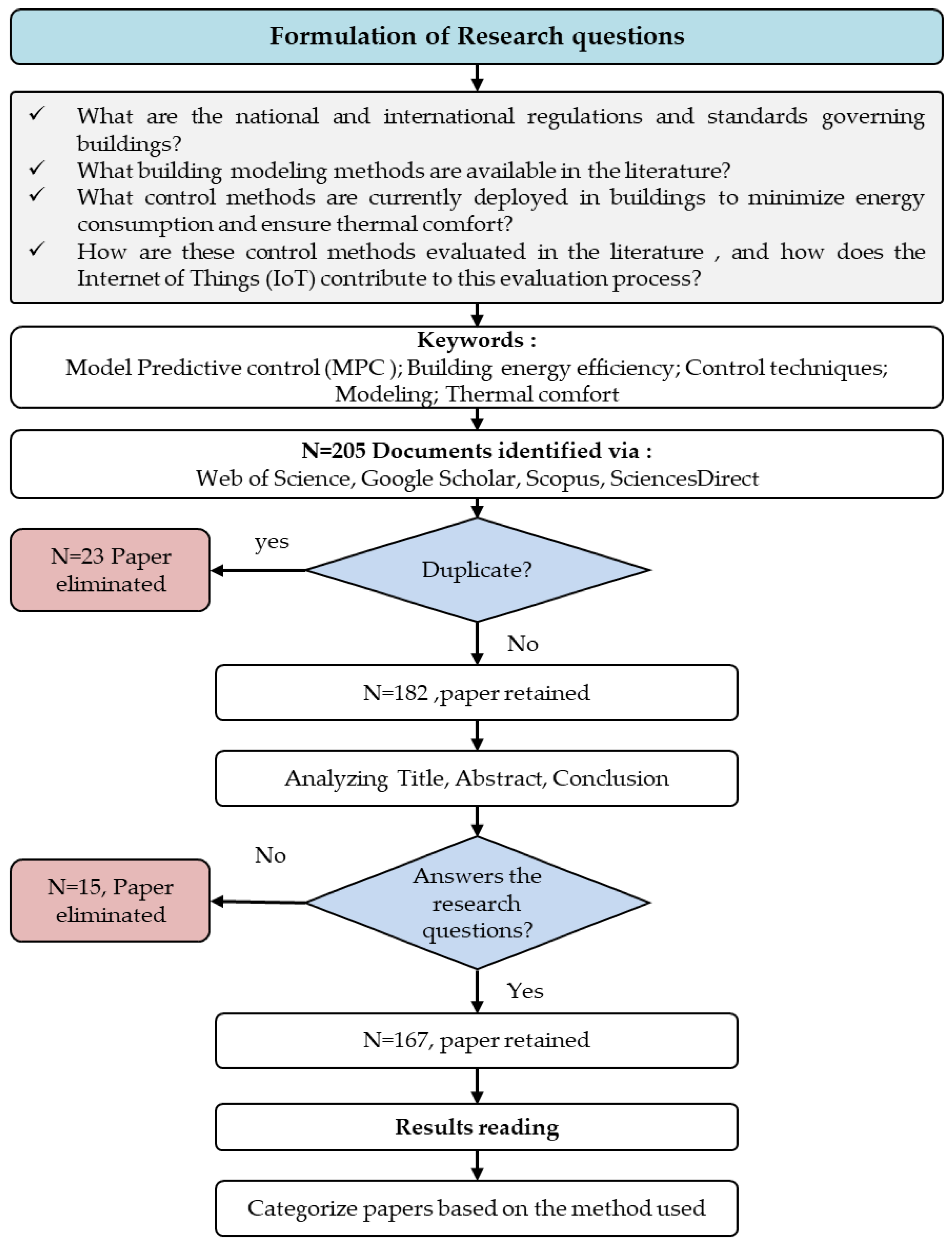
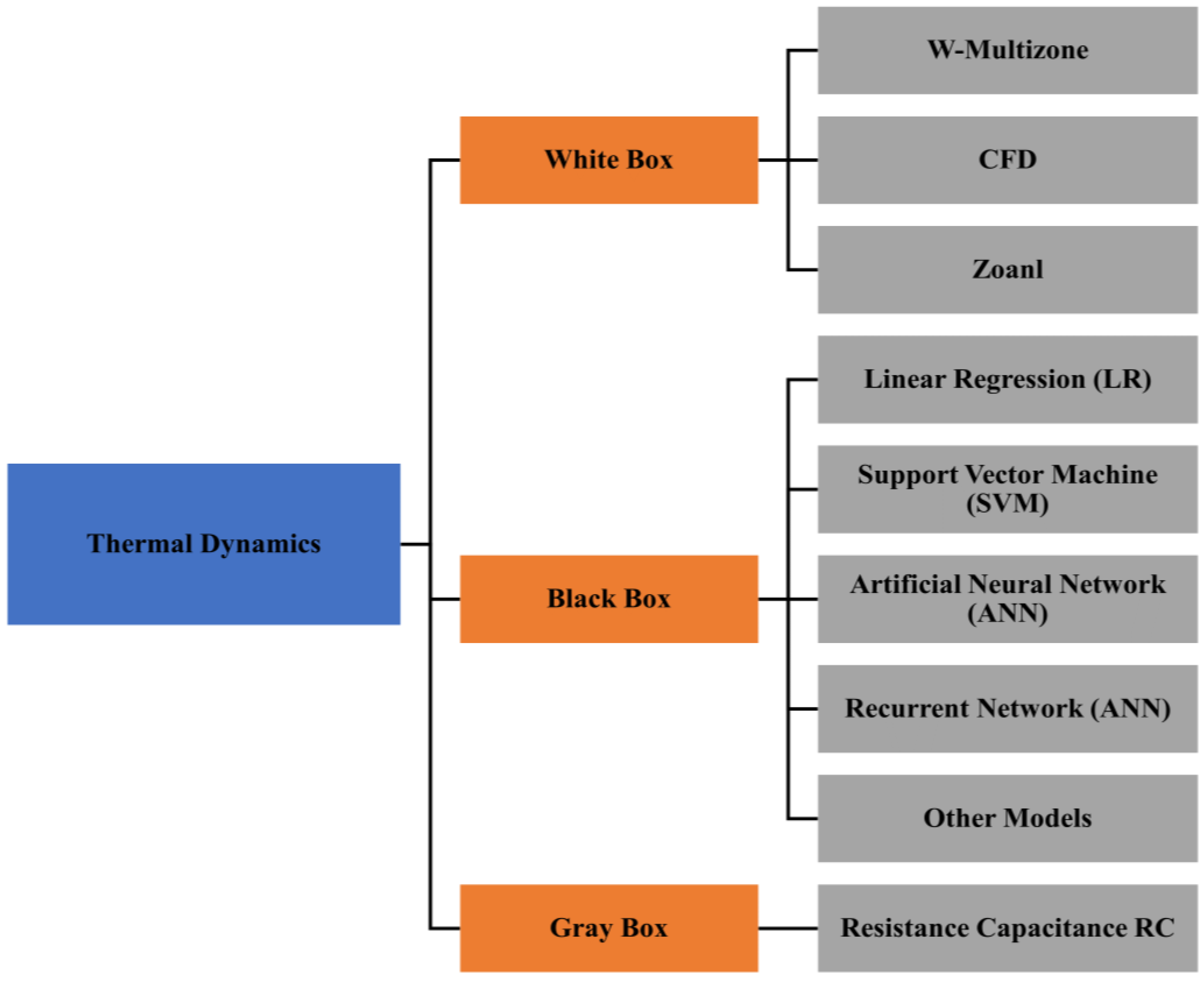
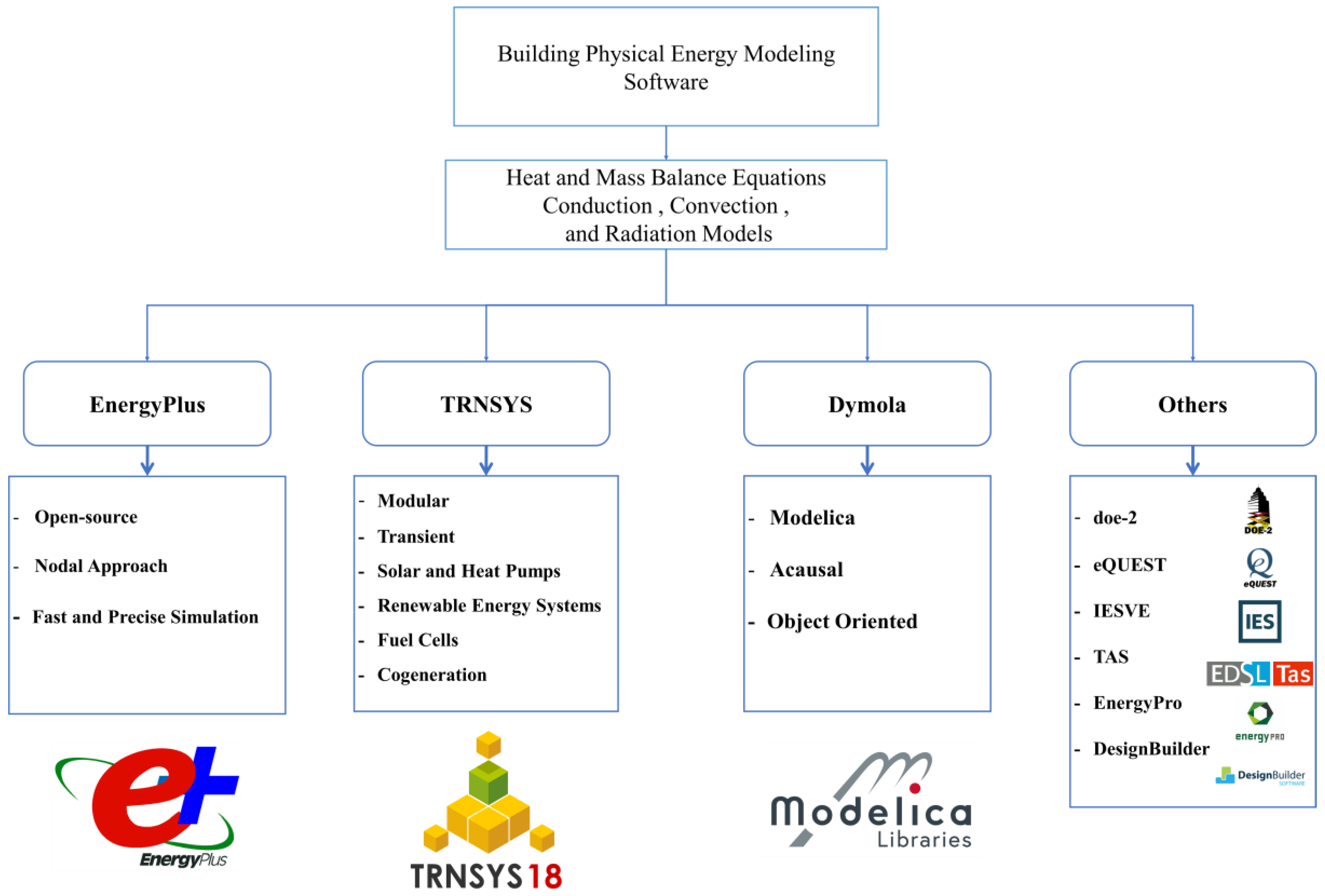
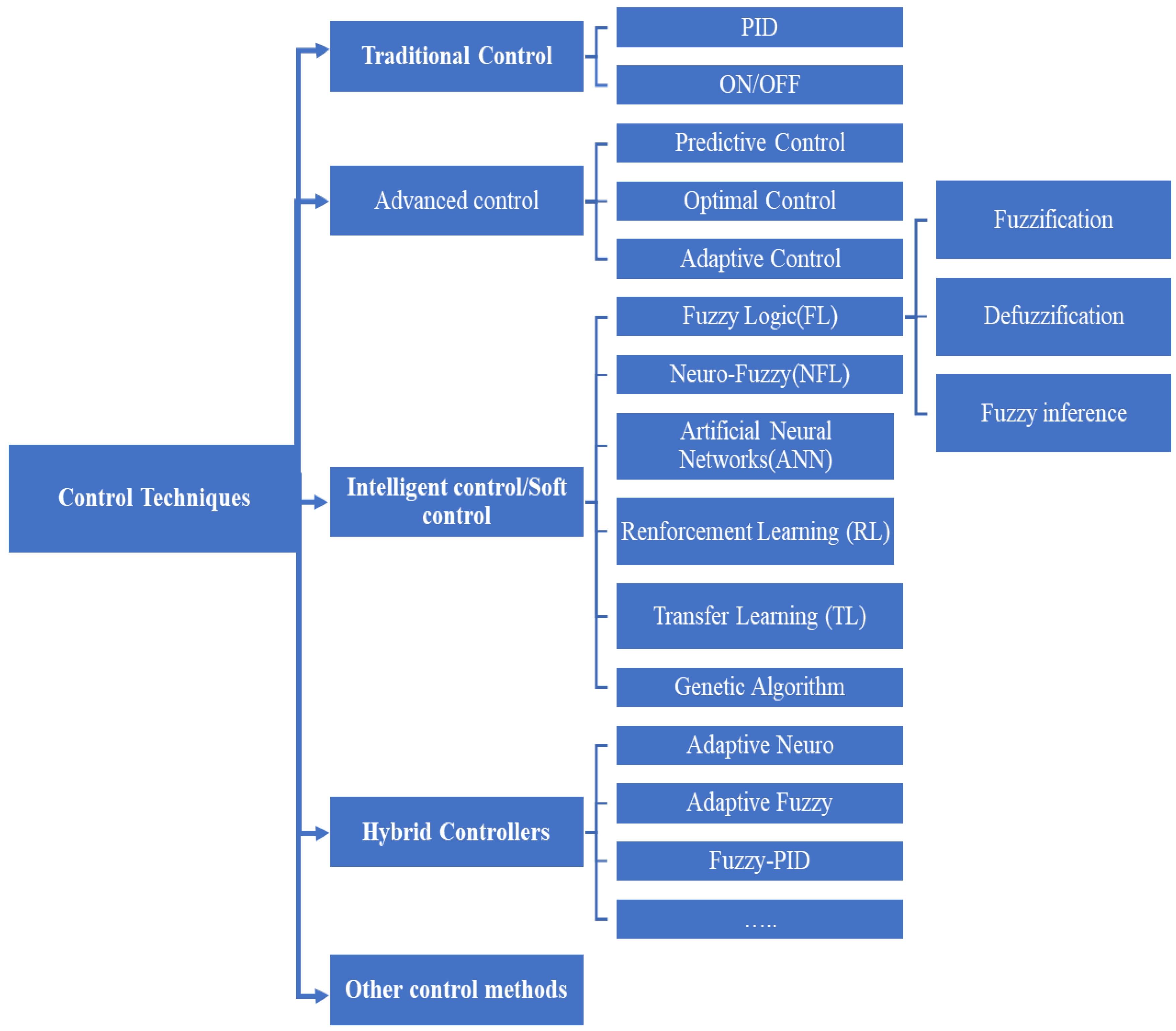
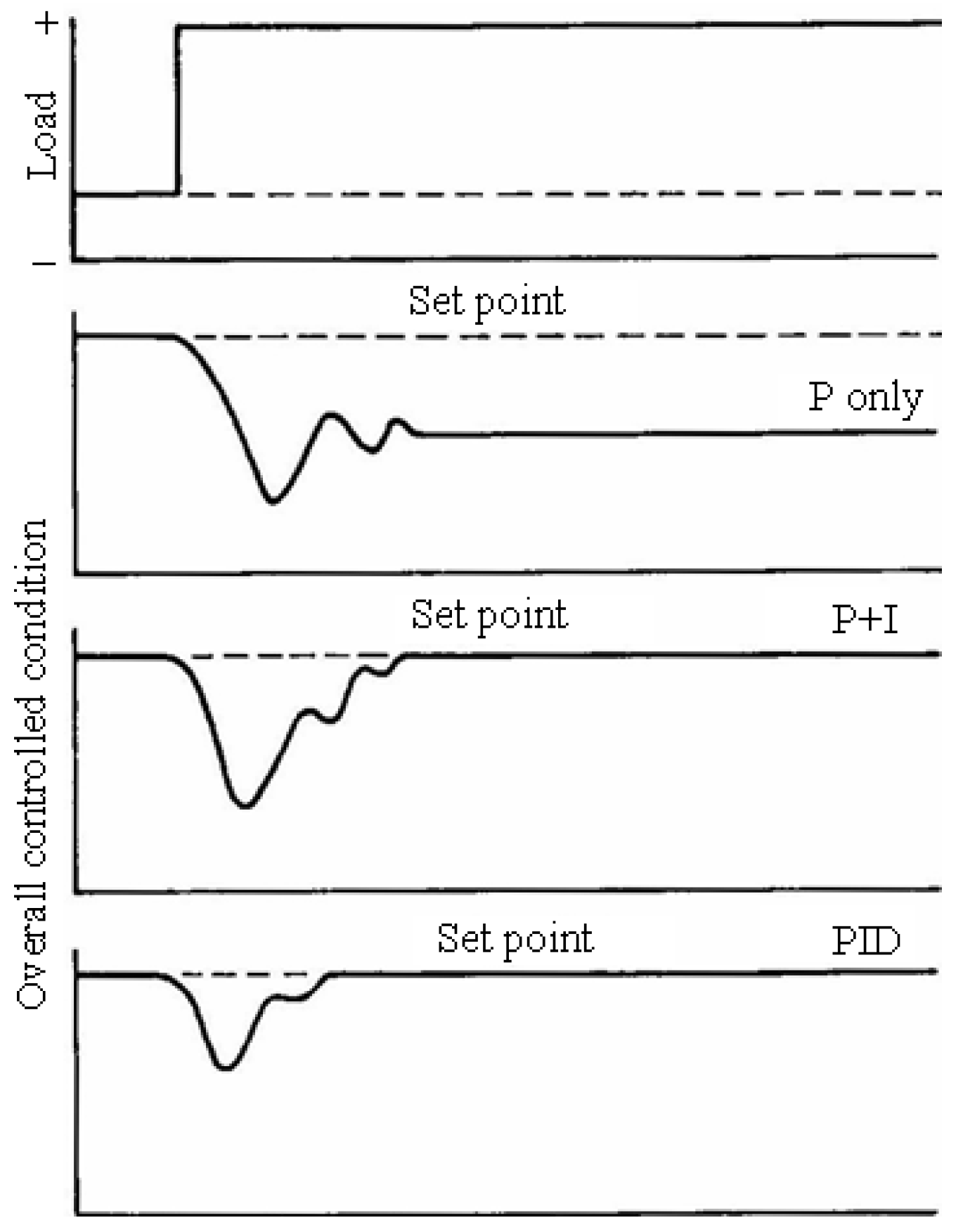
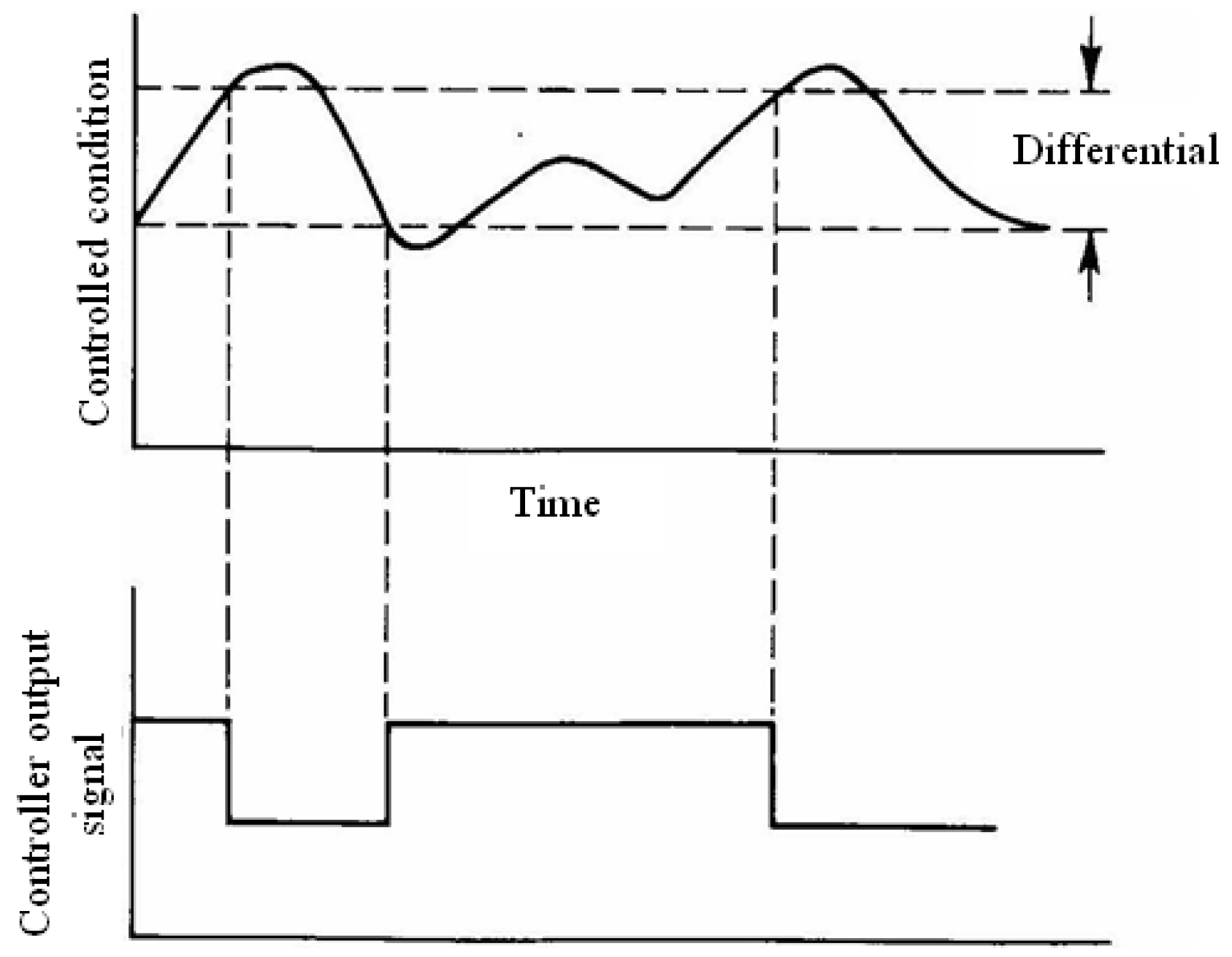
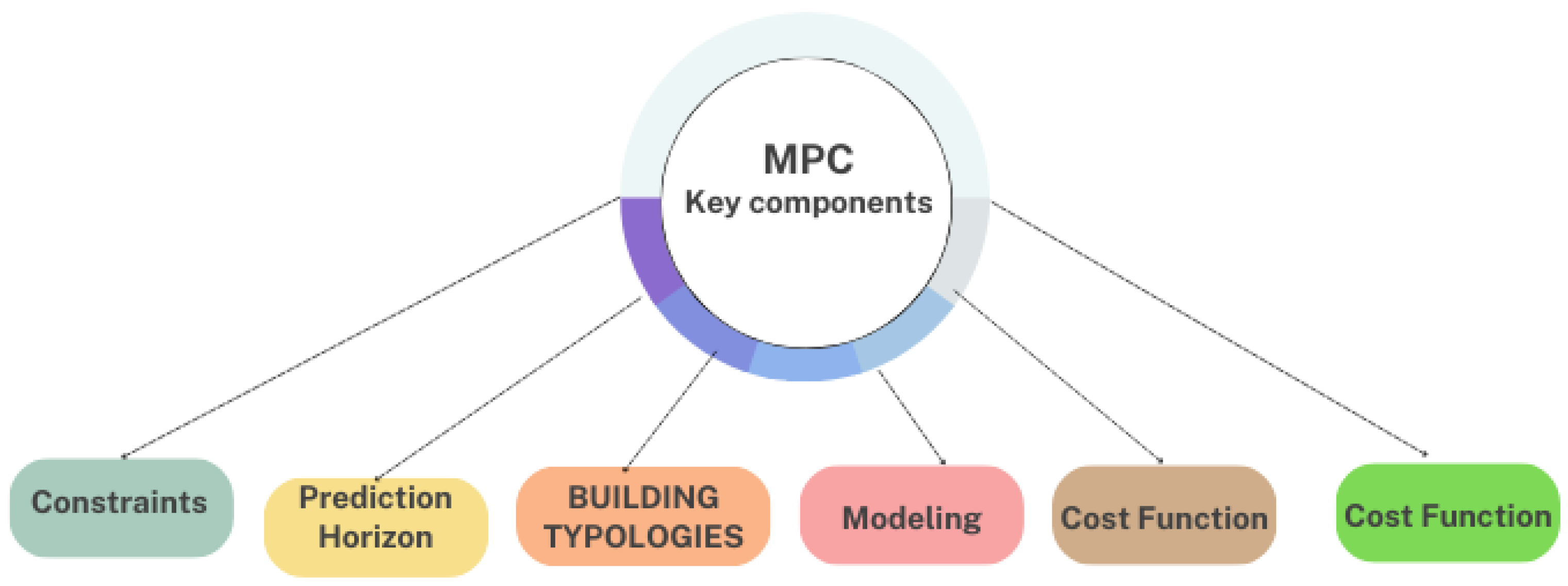
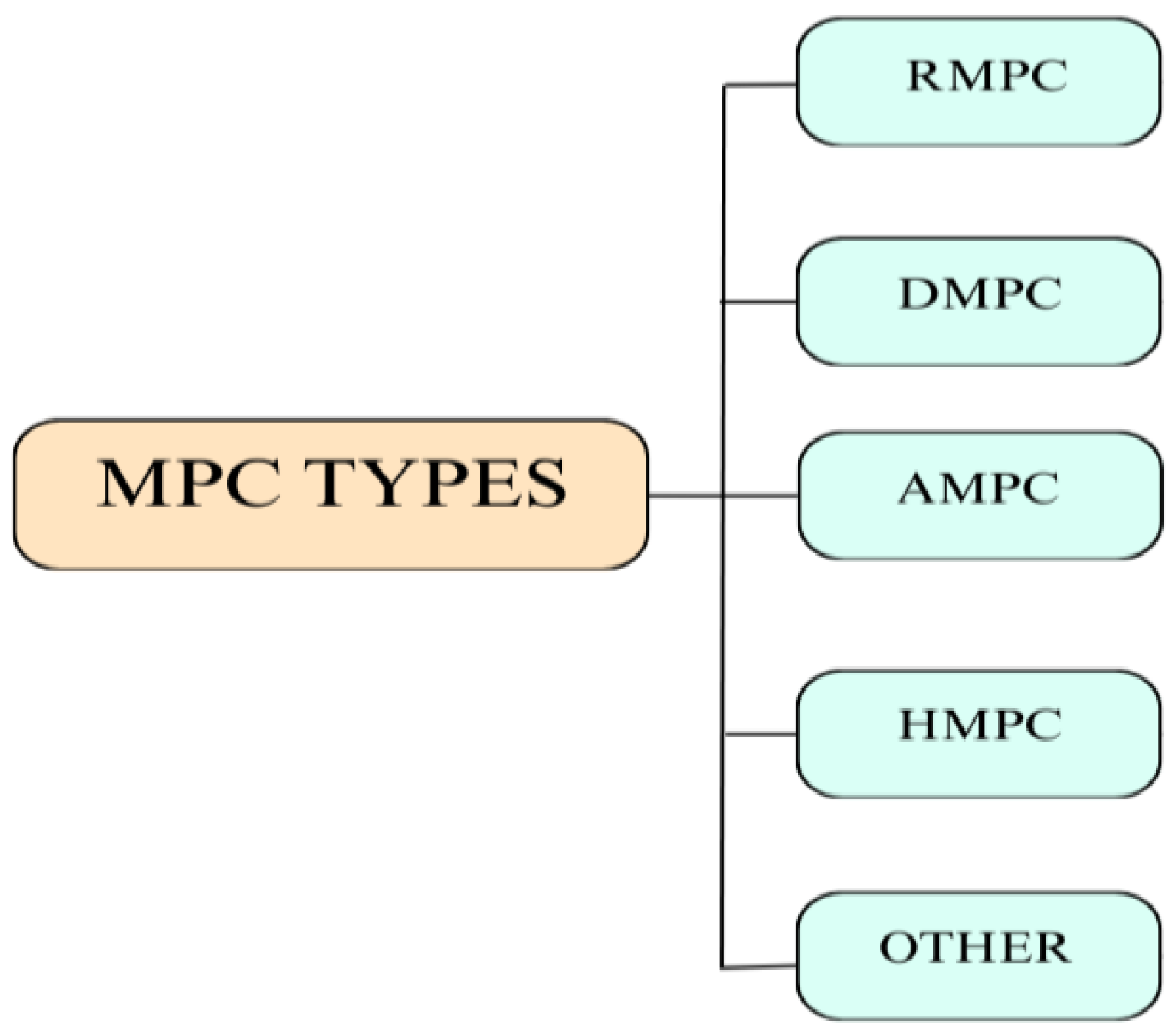
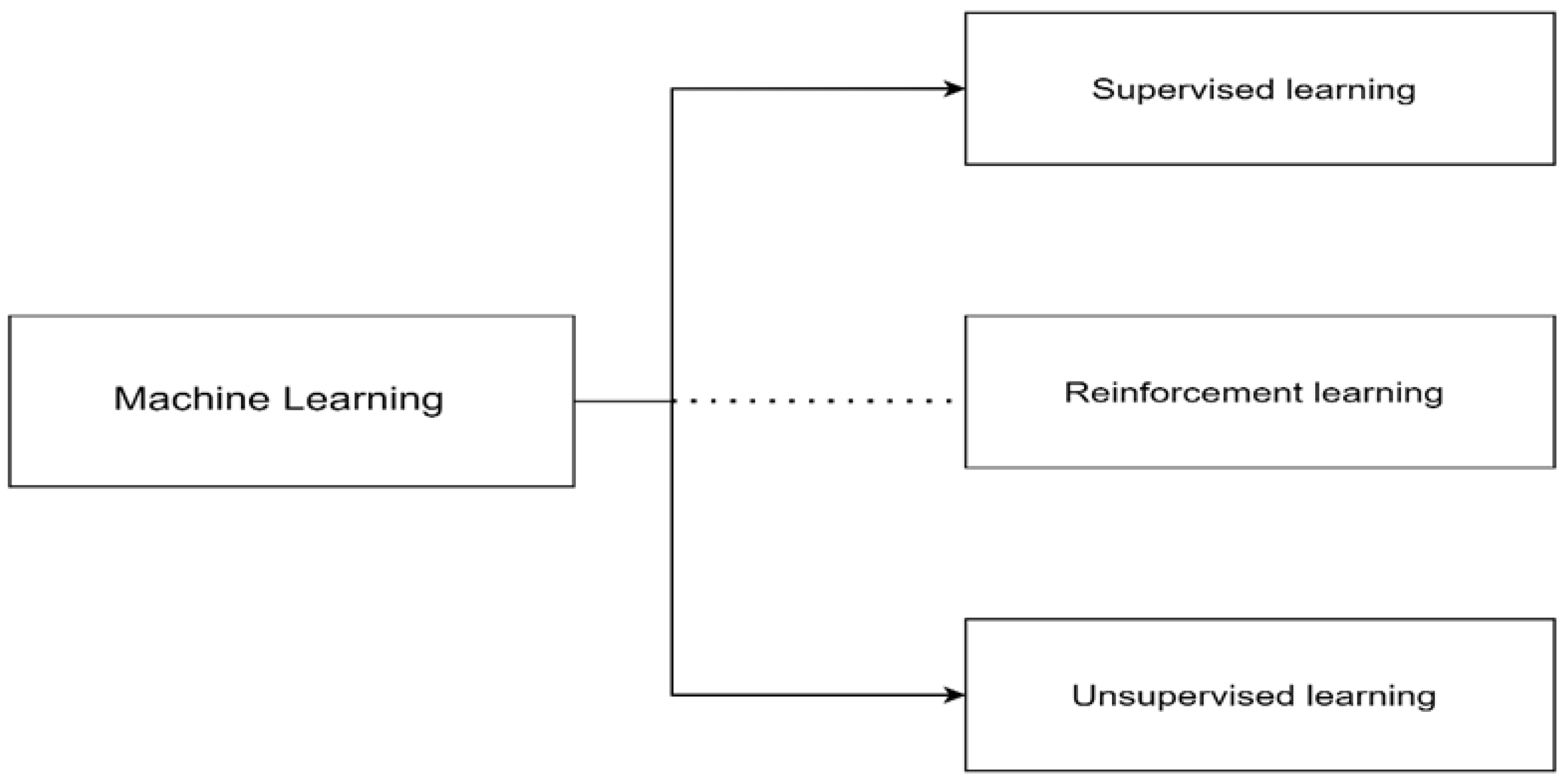
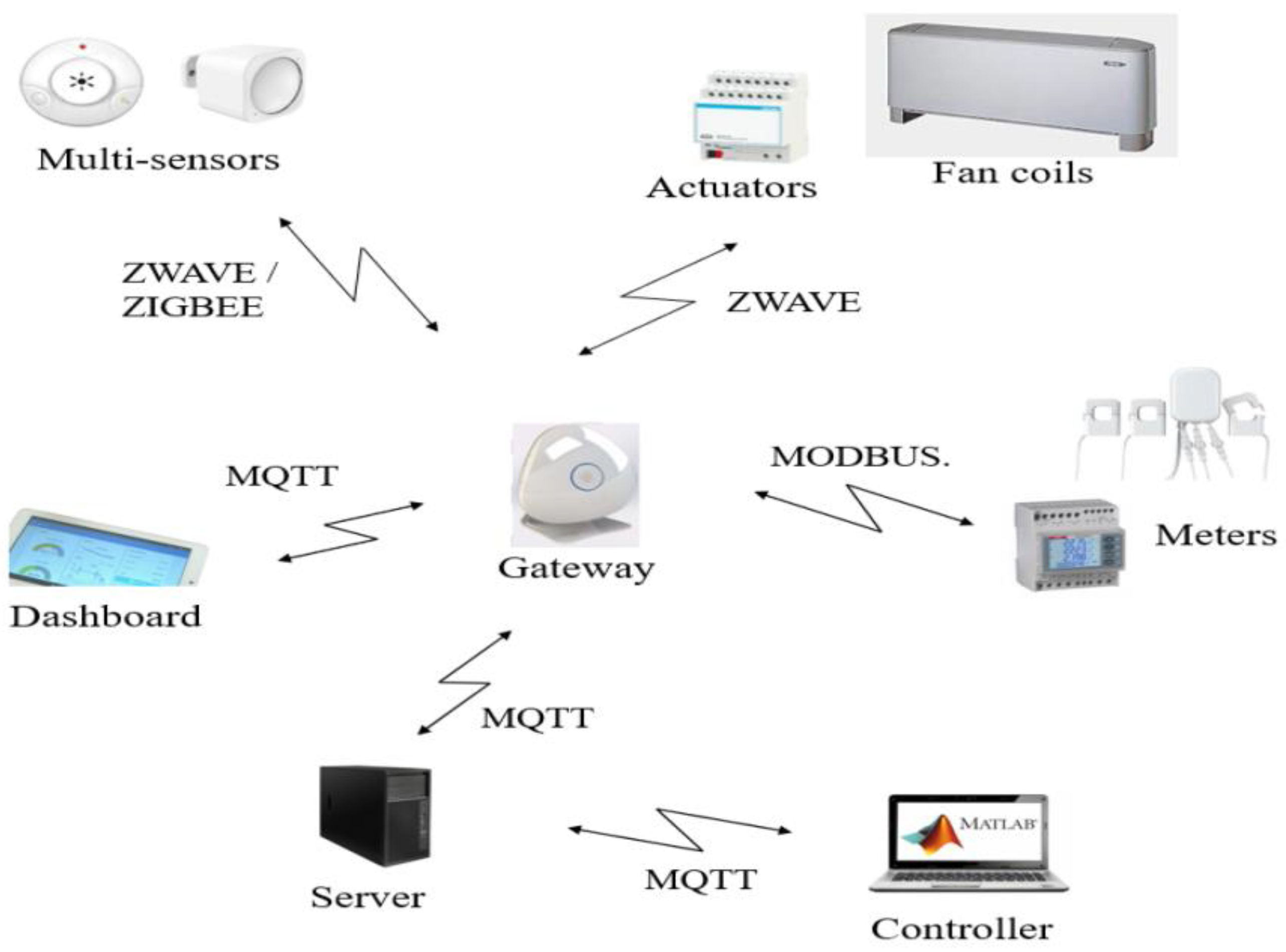
| Method | Advantages | Objectives | Applications | Limitations | Ref. |
|---|---|---|---|---|---|
| RMPC (Robust MPC) | Robustness to uncertainties and disturbances | In the presence of uncertainty, it maintains desirable setpoints and reacts to disturbances | Any HVAC system | Computation complexity, turning complexity, sensitivity to modeling errors | [95,96] |
| SMPC (Stochastic MPC) | Consideration of probabilistic nature of uncertainties | Maintains desired setpoints and responds to disturbances while considering the most likely disturbances that may be encountered in practice | HVAC systems with uncertain and varying disturbances | Computational complexity, potential for instability or oscillations, limited applicability to certain types of systems | [97,98] |
| DMPC (Distributed MPC) | Splits large-scale applications into smaller subproblems | Reduces computational burden and increases efficiency | Suitable for multizone buildings and water distribution systems | May lead to increased communication and implementation complexity | [99,100] |
| AMPC (Adaptive MPC) | Adaptability to changing system dynamics Handles model uncertainties and updates models based on data measurements | Responds to changes in system dynamics or parameters over time Ensures stability of the system | Suitable for non-linear and transient systems | May not work well with systems with large model uncertainties | [38,39] |
| HMPC (Hybrid MPC) | Energy savings and improved performance | Combines the benefits of different types of MPC systems to achieve better performance and energy efficiency | Additional complexity and computational requirements, potential for communication delays or failures | HVAC systems with multiple operation modes or components | [101] |
| Article | Advantages | Limitations | Sector | Software |
|---|---|---|---|---|
| [107] | Increases system efficiency and performance | Difficulty in modeling and accounting for uncertainty | Building energy system | Matlab |
| [108] | Improves energy efficiency and cost savings | Difficulty in modeling and accounting for weather uncertainty | Building | - |
| [108] | Improves system performance and energy efficiency | Limited scope of study and generalizability of results | Building | TRNSYS/MATLAB/ Co-simulation testbed |
| [106] | Improves energy efficiency and cost savings | The long short-term hybrid model is difficult to model and tune | Real office building | - |
| [109] | Increases cost savings and energy efficiency | Difficulty in modeling and training deep reinforcement learning models | Real office building in Pennsylvania | Intelligent work space |
| [110] | Increases energy efficiency and cost savings | Difficulty in modeling and training deep learning models | Building | Open Studio EnergyPlus |
| [111] | Improves control strategies for mixed-mode buildings | Limited to mixed-mode buildings | Building with mixed-mode cooling | Matlab EnergyPlus |
| Control Method | Ref. | Results | Software | Advantages | Disadvantages |
|---|---|---|---|---|---|
| Fuzzy Logic | [119] | Reductions of 21.75%, 30.77%, and 41.96% in energy consumption by using FLC for the HVAC, EWH, and dimmable lamp, respectively. | MATLAB SIMULINK, Fuzzy logic Toolbox | Energy Savings, cost reduction, improved efficiency, increased comfort. | Requires turning of fuzzy controller, has limited applicability to specific appliances and conditions. |
| [120] | Significant reduction in energy consumption by controlling the evaporator fan speed | MATLAB, Fuzzy Toolbox | Maintains ambient temperature at required set points. Reduces energy consumption. Improves thermal comfort. | Complexity in designing fuzzy control rules. Requires expertise in fuzzy logic control. | |
| [121] | Reduce the cost and energy consumption for peak period by 19.72% and 20.34%, by 26.71% and 26.67%, and by 37.5% and 33.33% for HVAC, EWH, and dimmable lamps, respectively, using FLC controller | Simulink/MATLAB | Provides energy utilization estimation and cost analysis. Achieves significant cost and energy savings during peak periods. Optimizes the schedule operation of home devices. | Requires modeling and analysis of household loads. Complexity in designing fuzzy-PSO controllers. Need for expertise in fuzzy logic and particle swarm optimization. | |
| [122] | Reduce the annual mean percentage of dissatisfied occupants by 33%; reduce the non-comfort hours by more than 50% | Energy Plus, Simulink, Building Control Virtual Test Tool, Control Virtual Test Bed, BCVTB | Enhances thermal comfort provision for building occupants. Promising method for dealing with multivariable control problems. | Real-life implementation needed to verify the potential of fuzzy control in HVAC applications. |
Disclaimer/Publisher’s Note: The statements, opinions and data contained in all publications are solely those of the individual author(s) and contributor(s) and not of MDPI and/or the editor(s). MDPI and/or the editor(s) disclaim responsibility for any injury to people or property resulting from any ideas, methods, instructions or products referred to in the content. |
© 2024 by the authors. Licensee MDPI, Basel, Switzerland. This article is an open access article distributed under the terms and conditions of the Creative Commons Attribution (CC BY) license (https://creativecommons.org/licenses/by/4.0/).
Share and Cite
Azzi, A.; Tabaa, M.; Chegari, B.; Hachimi, H. Balancing Sustainability and Comfort: A Holistic Study of Building Control Strategies That Meet the Global Standards for Efficiency and Thermal Comfort. Sustainability 2024, 16, 2154. https://doi.org/10.3390/su16052154
Azzi A, Tabaa M, Chegari B, Hachimi H. Balancing Sustainability and Comfort: A Holistic Study of Building Control Strategies That Meet the Global Standards for Efficiency and Thermal Comfort. Sustainability. 2024; 16(5):2154. https://doi.org/10.3390/su16052154
Chicago/Turabian StyleAzzi, Amal, Mohamed Tabaa, Badr Chegari, and Hanaa Hachimi. 2024. "Balancing Sustainability and Comfort: A Holistic Study of Building Control Strategies That Meet the Global Standards for Efficiency and Thermal Comfort" Sustainability 16, no. 5: 2154. https://doi.org/10.3390/su16052154
APA StyleAzzi, A., Tabaa, M., Chegari, B., & Hachimi, H. (2024). Balancing Sustainability and Comfort: A Holistic Study of Building Control Strategies That Meet the Global Standards for Efficiency and Thermal Comfort. Sustainability, 16(5), 2154. https://doi.org/10.3390/su16052154








